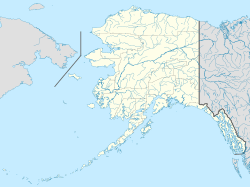Seward's Success, Alaska facts for kids
Quick facts for kids
Seward's Success, Alaska
|
|
|---|---|
|
Unbuilt Community
|
|
| Country | United States |
| State | Alaska |
| Borough | Matanuska-Susitna |
| Named for | William Seward |
Seward's Success was a huge idea for a new city in Alaska, United States. It was planned to be built near Anchorage, in a place called Point MacKenzie. This giant project was going to be completely covered by a massive dome! Inside, it would have homes, offices, shops, and fun places for 40,000 people. The idea came up in 1968 after a lot of oil was found in Alaska. But the project was stopped in 1972 because of delays in building the Trans-Alaska Pipeline System.
The name "Seward's Success" was a clever nod to "Seward's Folly". That was a nickname people gave to William H. Seward, who was a very important government official. He was in charge of buying Alaska for the United States in 1867.
Contents
A City Under a Dome: The Big Idea
The plan for Seward's Success started after oil was discovered in January 1968. This oil was found at Prudhoe Bay, a very northern part of Alaska. The whole project was expected to cost about $800 million. A company called Tandy Industries from Tulsa, Oklahoma, was going to build it. The design was by Adrian Wilson Associates from Los Angeles.
Building in Phases
The city was planned to be built in four main parts, or "phases." The first part was going to cost about $170 million. It was designed to hold 5,000 people. This first phase would also include a lot of office space, about 600,000 square feet (56,000 m2). There would also be 300,000 square feet (28,000 m2) of shops and an indoor sports arena. A key part of the office area was a planned 20-story building. It was called the Alaskan Petroleum Center. This building would be for oil companies and businesses that helped them. Seward's Success was promoted as the first city ever to be fully enclosed and have its climate controlled.
Getting Around Inside
Getting from Seward's Success to downtown Anchorage would start with a fast aerial tramway. Later, a monorail would be added. This monorail would connect the city to Anchorage International Airport. Inside Seward's Success, cars would not be allowed. People would get around using the aerial tramway, monorail, bicycle paths, and even moving sidewalks.
Climate and Energy
The temperature inside the dome would always be kept at a comfortable 68 °F (20 °C) all year. The dome itself would be made of glass. It was designed to work like a greenhouse, helping to keep the temperature steady. The city would get its power from natural gas. This gas was available right there at the building site.
Why the Project Was Stopped
Construction of Seward's Success was supposed to begin in 1970. The first steps were to build a dock and some roads. However, there were delays in building the Trans-Alaska Pipeline System. These delays were caused by lawsuits. Because of this, a company working for Tandy Industries could not make a payment. This payment was for the yearly lease of the 3,209 acres (12.99 km2; 5.01 sq mi) of land where Seward's Success was to be built. By 1972, the whole project was officially cancelled.


